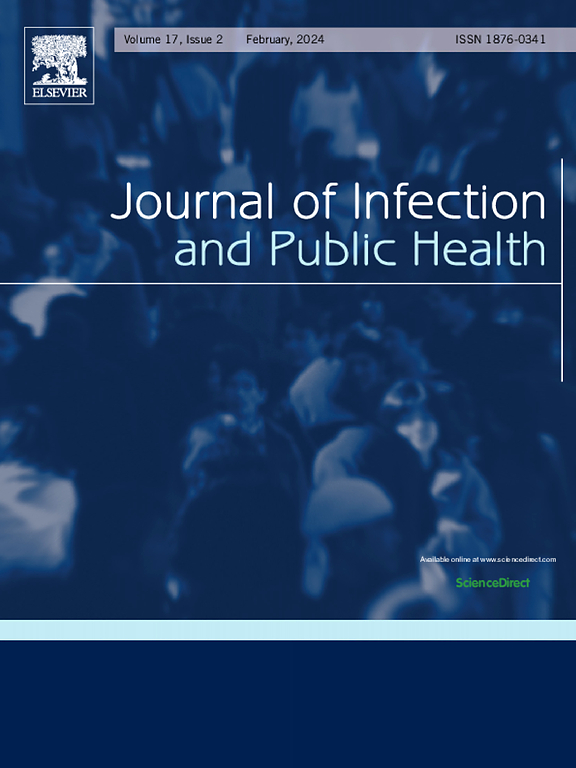Global, regional and national burden of echinococcosis in 204 countries and territories from 1990 to 2021: A systematic analysis based on the Global Burden of Disease Study 2021
IF 4
3区 医学
Q1 INFECTIOUS DISEASES
引用次数: 0
Abstract
Background
Echinococcosis, a neglected zoonotic helminthic disease, poses a significant health and economic burden globally. The study aimed to systematically analyze the burden of echinococcosis from 1990 to 2021. This study described incidence, prevalence, deaths, and disability-adjusted life years (DALYs) lost due to echinococcosis, explored trends in disease burden over time, identified high-burden regions and countries, and evaluated the contribution of various age and sex groups to the overall burden.
Methods
First, numbers and age-standardized rates of incidence, prevalence, deaths, and DALYs were assessed globally and by sub-types in 2021. Furthermore, the temporal trend of the disease burden was explored by the linear regression model from 1990 to 2021. Moreover, the age-period-cohort (APC) model and Bayesian age-period-cohort (BAPC) model were used to predict the future disease burden from 2022 to 2046. The Autoregressive Integrated Moving Average (ARIMA) model and the Exponential smoothing (ES) model were used for sensitivity analysis. To further delve into the factors driving changes in the disease burden between 1990 and 2021, decomposition analyses were conducted. Finally, frontier analysis was employed to assess the correlation between disease burden and sociodemographic development.
Results
Exposure to Echinococcosis contributed to 148521 incidence, 633404 prevalence, 1364 deaths, and 105072 DALYs globally in 2021. Younger and middle-aged adults were high-risk populations. Lower socio-demographic index (SDI) regions were high-risk areas. The disease burden varied considerably across the GBD regions and the countries. From 1990–2021, the number of incidence and prevalence cases increased. The predicted results showed that the incidence and prevalence for both genders would still increase from 2022 to 2046. Countries or regions with a higher SDI have greater burden improvement potential.
Conclusion
In conclusion, Echinococcosis has threatened public health globally. More proactive and effective strategic measures should be developed after considering global-specific circumstances.
1990年至2021年204个国家和地区棘球蚴病的全球、区域和国家负担:基于《2021年全球疾病负担研究》的系统分析
棘球蚴病是一种被忽视的人畜共患寄生虫病,在全球范围内造成了重大的健康和经济负担。本研究旨在系统分析1990 - 2021年棘球蚴病负担。本研究描述了包虫病的发病率、流行率、死亡率和残疾调整生命年(DALYs)损失,探讨了疾病负担随时间的变化趋势,确定了高负担地区和国家,并评估了不同年龄和性别群体对总体负担的贡献。方法首先,在2021年对全球范围内按亚型评估发病率、患病率、死亡率和DALYs的数量和年龄标准化率。利用线性回归模型分析1990 - 2021年疾病负担的时间变化趋势。此外,采用年龄-时期-队列(APC)模型和贝叶斯年龄-时期-队列(BAPC)模型预测2022 - 2046年未来疾病负担。采用自回归综合移动平均(ARIMA)模型和指数平滑(ES)模型进行敏感性分析。为了进一步深入研究1990年至2021年期间疾病负担变化的驱动因素,进行了分解分析。最后,采用前沿分析评估疾病负担与社会人口发展的相关性。结果2021年全球棘球蚴病暴露导致148521例发病率、633404例患病率、1364例死亡和105072例残疾死亡。年轻人和中年人是高危人群。社会人口指数(SDI)较低的地区为高危地区。不同GBD区域和国家的疾病负担差异很大。从1990年至2021年,发病率和流行病例数有所增加。预测结果显示,从2022年到2046年,男女的发病率和患病率仍将增加。SDI越高的国家或地区,负担改善潜力越大。结论棘球蚴病对全球公共卫生构成威胁。在考虑到全球具体情况后,应制定更积极有效的战略措施。
本文章由计算机程序翻译,如有差异,请以英文原文为准。
求助全文
约1分钟内获得全文
求助全文
来源期刊

Journal of Infection and Public Health
PUBLIC, ENVIRONMENTAL & OCCUPATIONAL HEALTH -INFECTIOUS DISEASES
CiteScore
13.10
自引率
1.50%
发文量
203
审稿时长
96 days
期刊介绍:
The Journal of Infection and Public Health, first official journal of the Saudi Arabian Ministry of National Guard Health Affairs, King Saud Bin Abdulaziz University for Health Sciences and the Saudi Association for Public Health, aims to be the foremost scientific, peer-reviewed journal encompassing infection prevention and control, microbiology, infectious diseases, public health and the application of healthcare epidemiology to the evaluation of health outcomes. The point of view of the journal is that infection and public health are closely intertwined and that advances in one area will have positive consequences on the other.
The journal will be useful to all health professionals who are partners in the management of patients with communicable diseases, keeping them up to date. The journal is proud to have an international and diverse editorial board that will assist and facilitate the publication of articles that reflect a global view on infection control and public health, as well as emphasizing our focus on supporting the needs of public health practitioners.
It is our aim to improve healthcare by reducing risk of infection and related adverse outcomes by critical review, selection, and dissemination of new and relevant information in the field of infection control, public health and infectious diseases in all healthcare settings and the community.
 求助内容:
求助内容: 应助结果提醒方式:
应助结果提醒方式:


